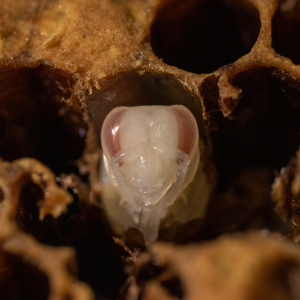1. Quantification of the sensitivity and communication responses in high and low-grooming honey bees (Apis mellifera) against the parasite Varroa destructor - Derek Micholson

The invasive ectoparasitic mite Varroa destructor is a major contributor to the deaths of honey bee colonies around the world every year. Currently, chemical miticides are the most common controls, however these methods are imperfect as they can lead to acaricide-resistant mites and chemical residues in wax and honey. Therefore, capitalizing on natural social-immunity behaviours, such as grooming behaviour, to breed bees resistant to varroa mites may be a good alternative method of control. Grooming behaviour has previously been studied quite thoroughly, however one unanswered question is whether bees from colonies exhibiting higher levels of grooming behaviour are more sensitive to external stimuli than low grooming bees. I hypothesize that bees from high-grooming colonies have heightened sensitivity to external stimuli and will thus show increased grooming responses to varroa mites as well as a secondary external stimulus (chalk dust). Further, I hypothesize that high-grooming colonies have enhanced communication mechanisms resulting in more effective grooming responses at the colony level. To test these theories, two separate laboratory experiments were conducted to observe individual bee behaviour as well as the behaviour of small cohorts of bees in cages from selected high and low-grooming colonies. This research has the potential to influence the pace at which varroa-resistant bees can be bred, if quicker screening techniques can be developed for these behaviours.

2. Transmission, impact, and mitigation of environmental honey bee viruses - Megan Colwell
Although there are many insect pollinators, European honey bees (Apis mellifera) are arguably the most economically important and recognizable pollinators. However, higher than normal population declines from overwintering losses in the past decade have put the honey bee industry at risk. Viruses are one of the key factors in honey bee health. Honey bee viruses have been studied extensively since their discovery, but much basic work remains to be done. Little work has been done to explore the possible role of wax, the substrate on which all hive activities take place, as an element in virus transmission. The ectoparasite Varroa destructor transmits viruses to and among honey bees, and is also responsible for spreading more virulent strains of some viruses. A colony with relatively high levels of Varroa generally also has higher levels of viruses. This relationship can be used to keep colonies with relative low or high virus levels to use in experiments. This project explores various routes of transmission of viruses between honey bees and wax, the effect of waxborne viruses on honey bees, and methods to potentially control those negative effects. Viruses are quantified using RT-qpcr.
3. Nosema epidemiology and control in honey bees (Apis mellifera) under Canadian Prairie conditions - Rosanna Punko

Infection of honey bee colonies with Nosema spp. has been reported to reduce adult bee populations and brood production, leading to increased winter colony losses. Alberta, one of the Canadian Prairie Provinces, experiences long, cold winters, and Nosema is typically among the top four factors causing colony mortality. Climatic differences across the province, as well as differences between wintering method (indoor vs. outdoor), can influence Nosema mean abundance in colonies. Fumagillin treatment, which has been shown to reduce Nosema abundance, can be applied in the spring or fall, but a need for both seasonal treatments has not been shown. The objective of this study is to determine the effect of geographical location, wintering method, and fumagillin treatment timing on Nosema abundance and honey bee colony strength and winter survival in Alberta.
